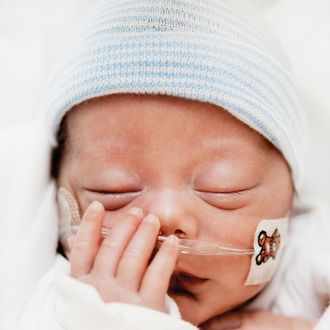
Jackson Shepherd was born, after just 27 weeks of gestation, on August 31. Weighing two and a half pounds and measuring fourteen and a quarter inches long, with a shock of dark hair, he spent the first two months of his life in the Neonatal Intensive Care Unit of NYU’s Langone Medical Center. Each day, Jackson’s mother, Jo-An Tremblay-Shepherd, traveled from her home in Dumbo to the sprawling hospital complex in the mid-Thirties along the East River to be with her son. By the end of October, machines still monitored Jackson’s vital signs 24 hours a day. But he had recently been designated a “feeder-grower,” and moved out of an incubator and into a bassinet. Soon, Jo-An thought, Jackson would be coming home.
On Monday morning, with Sandy closing in, Jo-An packed a bag, aiming to spend the night at the hospital. While NYU had closed for Irene and sent all but a few of its patients to other facilities, this time hospital officials decided simply to stop admitting new patients and relocate most existing patients, except the cases deemed too risky to move, including the twenty babies in the NICU.
But from the start, Sandy’s singular power was obvious. As Jo-An arrived at Langone, she noticed that one entrance smelled of sewage. By late afternoon, Jackson’s nurse, Sandra Kyong Bradbury (“Another Sandy,” Jo-An says), saw that the East River was pouring over the FDR Drive. Bradbury and the rest of the staff had been told that the hospital had a backup generator. But shortly after 8 p.m., the lights went out and the monitors not on battery power shut down. No emergency power came on-line.
Over the next fifteen hours, 298 patients at NYU were painstakingly escorted or carried down stairs to a platoon of waiting ambulances without a single fatality. That Jackson and the other NICU babies survived was especially remarkable. No one has been able to recall a forced NICU evacuation of this size. As many as six people escorted each of the twenty babies, fragile as they were, down nine flights, monitoring life-support systems and medications as med students lit the stairwells with flashlights. Bradbury was so focused on Jackson that she left her handbag and scarf behind. There wasn’t a single glitch.
Amid the sense of relief that ensued, there was also anger. Even as the evacuation was happening, Mayor Bloomberg said at a press conference: “The one thing that we had not counted on, New York University’s hospital backup power—in spite of them making sure, assuring us that it’s been tested—stopped working.”
Even before Katrina, hospitals have been aware of the vulnerability of backup generators. Moving NYU’s primary generator was on the wish list of its $3 billion modernization plan. And although the hospital said it tested the generator regularly, Gary Cohn, the president of Goldman Sachs and an NYU Langone trustee, told Bloomberg TV that everyone on the board knew the backup generators “are not state-of-the-art” and “not in the most state-of-the-art location.” One generator was in the basement. Other generators were on high floors, but their fuel tanks were also in the basement. Kenneth Langone, the Home Depot co-founder and NYU Langone board chairman, who has donated hundreds of millions of dollars to the hospital, said NYU had been prepared for a storm, just not one of this size. (Strangely enough, Langone was in the hospital that night being treated for pneumonia.) “We anticipated twelve-foot surges, which we knew we could handle,” Langone said. “We got fourteen-foot surges.”
To understand what happened and prevent a similar incident (a day after NYU was evacuated, virtually the same scenario began unfolding at Bellevue Hospital), City Council Speaker Christine Quinn has called for an inquiry. By Wednesday, NYU seemed to be attempting to redirect blame for the incident from the hospital to the city. It wasn’t the generators, technically speaking, that failed, said spokeswoman Lisa Greiner. It was the fuel tanks—tanks that are “required by code to be located in the lowest level of the building.”
Jo-An Tremblay-Shepherd is driving to the Bronx now to be with Jackson at Montefiore hospital. She blames NYU for “a huge lapse in judgment.” But she is in awe of the nurses who saved her son, especially the other Sandy. “In my estimation,” she says, “they are the highest.”





























